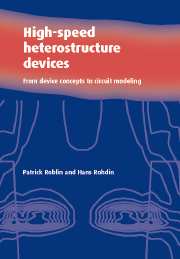Book contents
- Frontmatter
- Contents
- Preface
- Acknowledgements
- List of abbreviations
- Introduction
- 1 Heterostructure materials
- 2 Semiclassical theory of heterostructures
- 3 Quantum theory of heterostructures
- 4 Quantum heterostructure devices
- 5 Scattering processes in heterostructures
- 6 Scattering-assisted tunneling
- 7 Frequency response of quantum devices from DC to infrared
- 8 Charge control of the two-dimensional electron gas
- 9 High electric field transport
- 10 I – V model of the MODFET
- 11 Small- and large-signal AC models for the long-channel MODFET
- 12 Small- and large-signal AC models for the short-channel MODFET
- 13 DC and microwave electrothermal modeling of FETs
- 14 Analytical DC analysis of short-gate MODFETs
- 15 Small-signal AC analysis of the short-gate velocity-saturated MODFET
- 16 Gate resistance and the Schottky-barrier interface
- 17 MODFET high-frequency performance
- 18 Modeling high-performance HBTs
- 19 Practical high-frequency HBTs
- Index
16 - Gate resistance and the Schottky-barrier interface
Published online by Cambridge University Press: 06 July 2010
- Frontmatter
- Contents
- Preface
- Acknowledgements
- List of abbreviations
- Introduction
- 1 Heterostructure materials
- 2 Semiclassical theory of heterostructures
- 3 Quantum theory of heterostructures
- 4 Quantum heterostructure devices
- 5 Scattering processes in heterostructures
- 6 Scattering-assisted tunneling
- 7 Frequency response of quantum devices from DC to infrared
- 8 Charge control of the two-dimensional electron gas
- 9 High electric field transport
- 10 I – V model of the MODFET
- 11 Small- and large-signal AC models for the long-channel MODFET
- 12 Small- and large-signal AC models for the short-channel MODFET
- 13 DC and microwave electrothermal modeling of FETs
- 14 Analytical DC analysis of short-gate MODFETs
- 15 Small-signal AC analysis of the short-gate velocity-saturated MODFET
- 16 Gate resistance and the Schottky-barrier interface
- 17 MODFET high-frequency performance
- 18 Modeling high-performance HBTs
- 19 Practical high-frequency HBTs
- Index
Summary
Make everything as simple as possible, but not simpler.
Albert EinsteinIntroduction
The gate resistance Rg (Figure 15.16) has long been recognized as a very important parasitic parameter that can be difficult to reduce to an acceptable value. Rg degrades the noise figure and power gain. For the field-effect transistor (FET) depicted in Figure 14.1, the gate and drain voltages (and source ground) are applied to metal pads outside the active FET area. The gate, drain and source metallizations carry the currents laterally in the yz-plane onto the active FET area, and deliver the currents in an essentially uniform fashion in the x direction to the semiconductor. For the source and drain this is typically not a problem because of their larger extension in the y direction, and the thick interconnect metallizations available (neither is shown in Figure 14.1, which only depicts the central core of the device). The source and drain resistances (Rs and Rd) are thus not limited by the metallization resistance, but by the contact and semiconductor components discussed in Section 14.6.2. The situation is different for the gate because of its much smaller extension in the y direction. Consequently, in order to reduce the gate resistance for submicron gates, much effort has gone into developing T-gate processes (Figure 14.1; Section 17.7). This chapter will show that there is much more to the gate resistance, and therefore that there are additional ways to reduce it. In particular, we will discuss an interfacial component which, in its purest form, is intimately tied to the mechanism responsible for Schottky-barrier formation.
- Type
- Chapter
- Information
- High-Speed Heterostructure DevicesFrom Device Concepts to Circuit Modeling, pp. 527 - 566Publisher: Cambridge University PressPrint publication year: 2002

